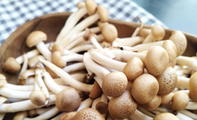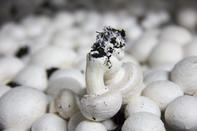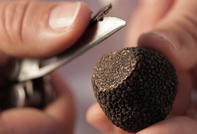
The most common way to eat mushrooms is either raw in salads or cooked in butter, oil or ghee. Mushrooms may also be dried, canned, powdered and be processed into crisps, ready-made sauces and soups.
Dried mushrooms are rehydrated in water or broth while dried powdered mushrooms can be sprinkled into dishes like soups and sauces. Mushrooms can be marinated and pickled with a combination of ingredients like wine, oil, vinegar, garlic, herbs and spices. Mushroom paste (mashed mushrooms, oil, nuts, herbs and spices) are generally used as bread and pasta toppings, and as an accompaniment to grilled meats.
Other mushroom-related products include mushroom biltong, mushroom leather and self-growing mushroom kits. Biltong is traditionally a spicy dried meat made from marinated and spiced meat cuts. Mushroom biltong is a vegan-friendly snack made from marinated and dried sliced mushrooms such as shiitake or oyster mushrooms.
Mushroom leather grows from mycelium (the root-like structure of fungi) and takes two weeks to grow to the size of a standard cowhide. Self-growing mushroom kits include the spores and substrate to grow shiitake, enoki and oyster mushrooms.
Mushrooms are also available as immune-supporting health supplements, mushroom coffee with cordyceps mushrooms and are used in skincare.
How to Eat Mushrooms

Some mushrooms can be eaten raw in salads but most mushrooms are cooked with oil, butter or ghee. It is believed that grilling and microwaving mushrooms are the healthiest ways to cook mushrooms.
When cooking mushrooms, chefs recommend adding salt and pepper at the end of the cooking process. Adding salt while cooking the mushrooms draws out the liquid and can slow down the browning process.
The thick, meaty texture and umami flavour of mushrooms makes it an ideal meat replacement in vegetarian and vegan diets. Mushrooms are high in guanylate, a compound that contributes to the savoury umami flavour. The umami flavour increases as brown button mushrooms mature to large brown mushrooms (portabella). Fresh and dried shiitake mushrooms are especially abundant in umami flavour compounds.
Storing of Mushrooms

Ideally, mushrooms should be stored in paper bags to absorb any moisture that may form when temperatures fluctuate during storage. The shelflife of mushrooms are between five and seven days, but always buy firm mushrooms - sponginess and elongated stems (in Agaricus spp) are often signs that mushrooms close to the end of their shelflife.
Mushroom Compost
Apart from producing edible mushrooms, a useful byproduct of mushroom farming is the spent mushroom compost. Mushroom compost is made from straw, chicken manure, gypsum and water. After mushrooms are harvested, the spent compost can be used in soil to improve water infiltration, water holding capacity, as well as help with the detoxification of toxic soil and increase organic matter content.
Spent mushroom compost may contain salts and unstable organic material, so it should be further composted to enable proper incorporation into the soil and utilisation by soil microbes.
What are Truffles?

Truffles, the fruiting bodies of underground fungi, is an expensive delicacy that grows under special soil conditions and is usually associated with tree roots. There are many species of truffles often growing in specific regions and associated with certain trees. For example, the black truffle is found near oak, cherry and hazelnut trees in the Périgord region of France.
Most cultivated truffles come from Spain, but truffles can be wild-harvested as well.
There is some truffle cultivation in South Africa. The cultivation is limited to areas with an average winter temperature of 8℃ and focuses mostly on the black Périgord truffle in association with inoculated oak trees.
By Marinda Louw